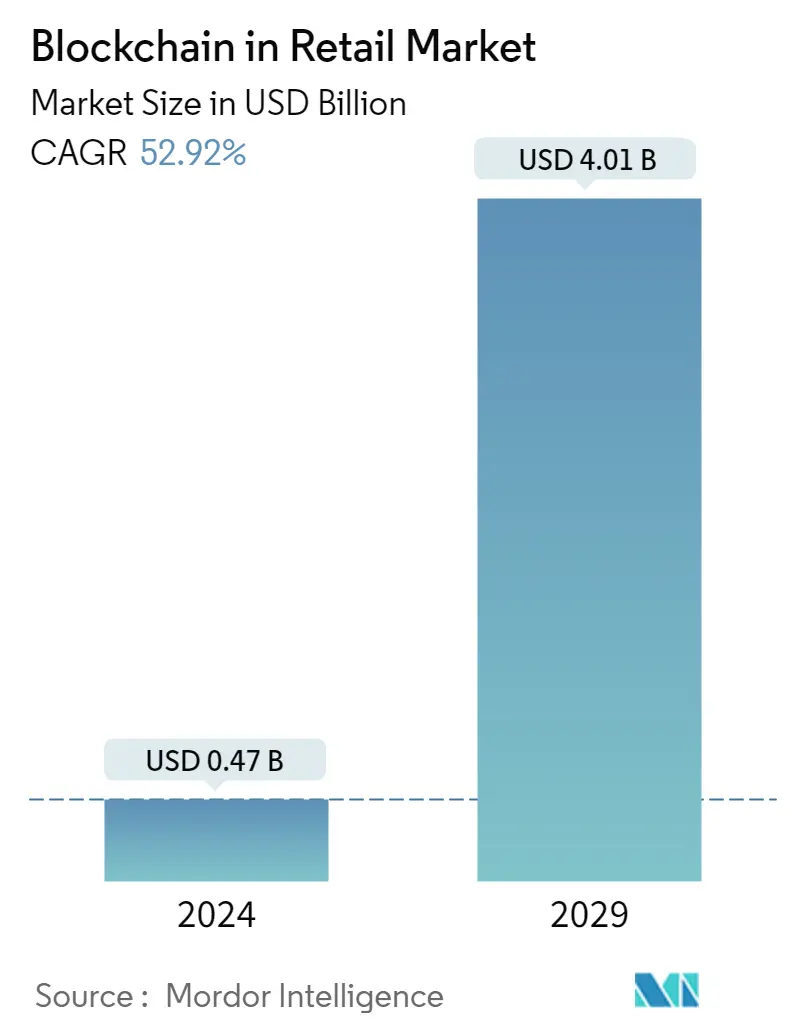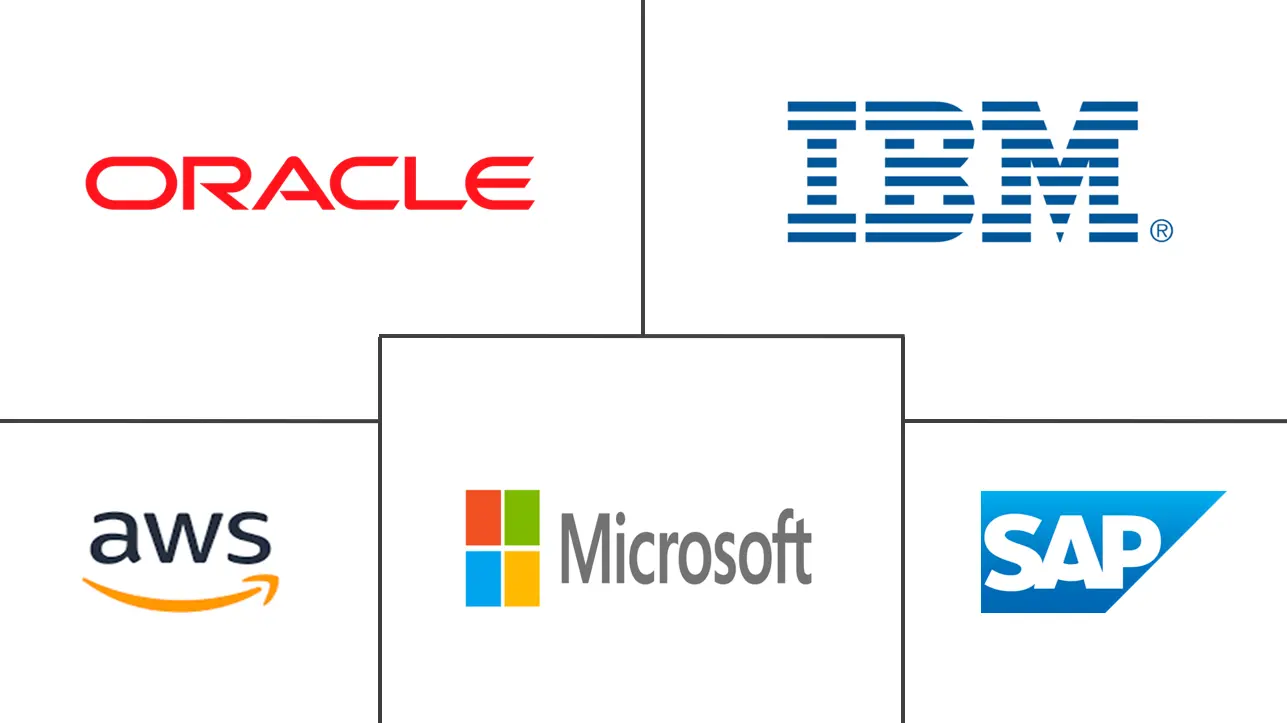Market Size of Blockchain in Retail Industry

| Study Period | 2019 - 2029 |
| Market Size (2024) | USD 0.47 Billion |
| Market Size (2029) | USD 4.01 Billion |
| CAGR (2024 - 2029) | 52.92 % |
| Fastest Growing Market | Asia Pacific |
| Largest Market | North America |
| Market Concentration | Low |
Major Players
*Disclaimer: Major Players sorted in no particular order |
Blockchain in Retail Market Analysis
The Blockchain in Retail Market size is estimated at USD 0.47 billion in 2024, and is expected to reach USD 4.01 billion by 2029, growing at a CAGR of 52.92% during the forecast period (2024-2029).
- The increasing demand for transparency in the retail supply chain, the fast, frictionless transactions, and the demand for improved customer service are driving the blockchain in retail market growth.
- Blockchain technology empowers retail businesses to maintain transparent, secure record-keeping, track the provenance of goods, and provide a method to engage in secure transactions. In addition, blockchain technology in the retail sector helps store digital records safely and audibly, enabling a safe, speedy, and cost-effective transfer of assets. Thus driving the demand for blockchain in the retail segment.
- The advantages of blockchain to improve the value chain for the retail business are significant and have gained substantial traction over the past few years, thus positively impacting the market growth. By putting data and transactions on the digital ledger, the speed of transactions can be quicker, paper-based processes can be eliminated, goods can be traced across diverse supply chains, and fake goods can be filtered out.
- Moreover, consumer demand for fast, frictionless transactions is leading to sharp increases in mobile and online e-commerce fraud and associated costs. Blockchain technology is significantly enabling fast, frictionless, and secure transactions in the retail segment. Additionally, Blockchain efficiency in handling, securing, and decentralizing loyalty program data is also driving the adoption of blockchain in the retail segment. The technology facilitates the creation and transmission of points across programs and retailers.
- Additionally, the increasing retail theft drives the blockchain technology demand in the retail sector for fraud prevention and detection. For instance, according to the data from the National Retail Federation's 2022 Retail Security Survey, retail losses from stolen goods increased to USD 94.5 billion in 2021, up from USD 90.8 billion in 2020.
- The COVID-19 pandemic lowered consumers' financial potential, decreasing retail blockchain services and solutions sales. However, post-pandemic, retail industries started recovering from economic setbacks during the outbreak and are expected to provide significant opportunities for the growth of blockchain in the retail segment over the forecast period.
Blockchain in Retail Industry Segmentation
Originally used only for financial transactions, blockchain has expanded its roots to other industries, including retail, which is changing the way retailers and suppliers are earning consumer loyalty. It makes the retailers equipped to deal with challenges in transaction management, customer service or inventory management.
The Blockchain in Retail Market is segmented by Application (Compliance Management, Smart Contract, Supply Chain and Inventory Management, Transaction Management, Automated Customer Service, Identity Management), and Geography (North America, Europe, Asia Pacific, Rest of the World).
The market sizes and forecasts are provided in terms of value (USD) for all the above segments.
| By Application | |
| Compliance Management | |
| Smart Contract | |
| Supply Chain and Inventory Management | |
| Transaction Management | |
| Automated Customer Service | |
| Identity Management |
| Geography | |
| North America | |
| Europe | |
| Asia-Pacific | |
| Rest of the World |
Blockchain in Retail Market Size Summary
The blockchain technology market in retail is experiencing rapid growth, driven by the increasing demand for transparency in supply chains, the need for fast and secure transactions, and the desire to enhance customer service. This technology enables retailers to maintain secure and transparent record-keeping, track the provenance of goods, and engage in secure transactions, thereby improving the value chain. The shift towards digital ledgers eliminates paper-based processes, enhances transaction speed, and helps in tracing goods across supply chains, which is crucial in combating counterfeit products. Additionally, the rise in mobile and online e-commerce fraud has heightened the need for blockchain solutions, as they offer a secure method for handling loyalty program data and preventing retail theft. The post-pandemic recovery has further fueled the adoption of blockchain in retail, providing significant growth opportunities.
North America is poised to hold a significant share of the blockchain in retail market due to its early adoption of advanced technologies and the presence of major market players like IBM, Oracle, and Amazon Web Services. These companies are continuously innovating their blockchain solutions to enhance operational efficiency and security in retail businesses. Retailers such as Walmart are integrating blockchain into their supply chains to improve automation and traceability. The market is characterized by fragmentation, with numerous vendors offering solutions for both online and offline retailers. Key players are engaging in partnerships, mergers, and acquisitions to expand their market presence. Notable developments include collaborations between VeChain and Walmart China to enhance supply chain management, and Flipkart's partnership with Polygon to explore Web3 and metaverse commerce use cases.
Blockchain in Retail Market Size - Table of Contents
-
1. MARKET INSIGHTS
-
1.1 Market Overview
-
1.2 Industry Attractiveness - Porter's Five Force Analysis
-
1.2.1 Bargaining Power of Suppliers
-
1.2.2 Bargaining Power of Buyers
-
1.2.3 Threat of New Entrants
-
1.2.4 Threat of Substitute Products
-
1.2.5 Intensity of Competitive Rivalry
-
-
1.3 Assessment of Impact of COVID-19 on the Market
-
-
2. MARKET SEGMENTATION
-
2.1 By Application
-
2.1.1 Compliance Management
-
2.1.2 Smart Contract
-
2.1.3 Supply Chain and Inventory Management
-
2.1.4 Transaction Management
-
2.1.5 Automated Customer Service
-
2.1.6 Identity Management
-
-
2.2 Geography
-
2.2.1 North America
-
2.2.2 Europe
-
2.2.3 Asia-Pacific
-
2.2.4 Rest of the World
-
-
Blockchain in Retail Market Size FAQs
How big is the Blockchain in Retail Market?
The Blockchain in Retail Market size is expected to reach USD 0.47 billion in 2024 and grow at a CAGR of 52.92% to reach USD 4.01 billion by 2029.
What is the current Blockchain in Retail Market size?
In 2024, the Blockchain in Retail Market size is expected to reach USD 0.47 billion.

